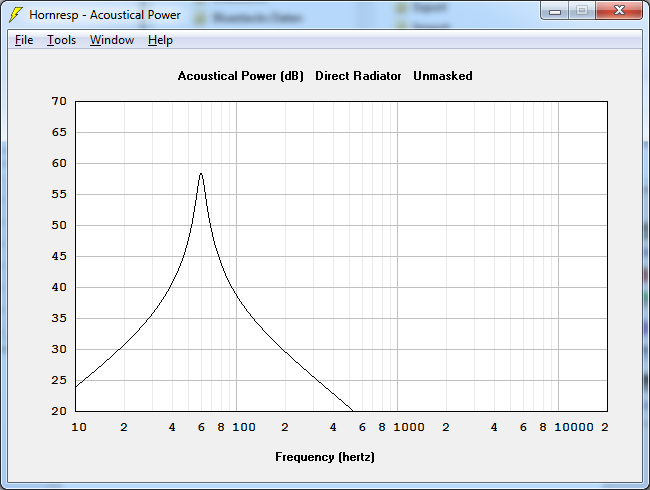Hello guys, and especially hello David! 🙂
In the last few days, i was simulating a couple enclosures for my subwoofer (mostly with WinISD).
I allways liked the idea of a 6th order serial tuned bandpass, wich was unable to simulate until now, when i finally found Hornresp!!!
But i am pretty confused, at what Hornresp outputs me, compared to WinISD
I got strange peaks in the result, so i simulated a simple closed box, to see, if atleast this looks familiar, wich was NOT the case.
When simulating a closed box, im get just 1 big peak as result, like the following picture shows:

The same driver, in the same 5l closed box in WinISD looks like this:

I mean... ok... im sure the flat line at 100Hz and above is not true in WinISD, but this peak in Hornresp also looks unreal to me.
But it is not just the way, how it looks, also the point, where it starts dropping is totally different.
-> WinISD starts dropping at ~100Hz and below, the Hornresp simulation has its peak at 60Hz and drops below that
Just to let you have all the informations, here a screenshot of my input window:

I realised, when i choose "-> Tools -> Maximum SPL", it looks a bit more, like what WinISD outputs, BUT still verry different AND, i can not select this menu, when i simulate the bandpass. The menu is just not there, when i select a bandpass simulation, instead of a closed box.
Edit:
i am sorry, i didnt want to double-post. I allready posted my question into another thread, but i didnt know, it takes a while, until it shows up... so i thought my post didnt submit correctly, and posted it again here.
In the last few days, i was simulating a couple enclosures for my subwoofer (mostly with WinISD).
I allways liked the idea of a 6th order serial tuned bandpass, wich was unable to simulate until now, when i finally found Hornresp!!!
But i am pretty confused, at what Hornresp outputs me, compared to WinISD
I got strange peaks in the result, so i simulated a simple closed box, to see, if atleast this looks familiar, wich was NOT the case.
When simulating a closed box, im get just 1 big peak as result, like the following picture shows:
The same driver, in the same 5l closed box in WinISD looks like this:
I mean... ok... im sure the flat line at 100Hz and above is not true in WinISD, but this peak in Hornresp also looks unreal to me.
But it is not just the way, how it looks, also the point, where it starts dropping is totally different.
-> WinISD starts dropping at ~100Hz and below, the Hornresp simulation has its peak at 60Hz and drops below that
Just to let you have all the informations, here a screenshot of my input window:
I realised, when i choose "-> Tools -> Maximum SPL", it looks a bit more, like what WinISD outputs, BUT still verry different AND, i can not select this menu, when i simulate the bandpass. The menu is just not there, when i select a bandpass simulation, instead of a closed box.
Edit:
i am sorry, i didnt want to double-post. I allready posted my question into another thread, but i didnt know, it takes a while, until it shows up... so i thought my post didnt submit correctly, and posted it again here.
Last edited:
Guys, someone told me, i just had the wrong Le.
Its 1.8 and not 1800.... i made a copy/paste error with that, and did not realise it.
Anyhow WinISD does not care about LE at all, thats why i did not realise it myself.
Have a great day 🙂
Its 1.8 and not 1800.... i made a copy/paste error with that, and did not realise it.
Anyhow WinISD does not care about LE at all, thats why i did not realise it myself.
Have a great day 🙂
Greets!
Correct!
Hmm, WinISD Pro freeware did back when HR was basically a classic horn designer and the updated version on FB does too IIRC, but there is [was?] an option that needs to be clicked on to sim in a more pro/advanced mode, i.e. when it was updated [redesigned from scratch?] due to windoze updates they combined the basic [default] and pro versions into one with comparable accuracy to other [then] popular programs.
Note that T/S theory peters out at 2*Fs/Qts', ergo mass [Mms] roll-off, inductance [Le] governs its basic mids/HF response.
[Qts']: [Qts] + any added series resistance [Rs]: Calculate new Qts with Series Resistor
[Rs] = 0.5 ohm minimum for wiring, so may be higher if a super small gauge is used as a series resistor plus any added resistance from an XO/whatever.
Correct!
Hmm, WinISD Pro freeware did back when HR was basically a classic horn designer and the updated version on FB does too IIRC, but there is [was?] an option that needs to be clicked on to sim in a more pro/advanced mode, i.e. when it was updated [redesigned from scratch?] due to windoze updates they combined the basic [default] and pro versions into one with comparable accuracy to other [then] popular programs.
Note that T/S theory peters out at 2*Fs/Qts', ergo mass [Mms] roll-off, inductance [Le] governs its basic mids/HF response.
[Qts']: [Qts] + any added series resistance [Rs]: Calculate new Qts with Series Resistor
[Rs] = 0.5 ohm minimum for wiring, so may be higher if a super small gauge is used as a series resistor plus any added resistance from an XO/whatever.